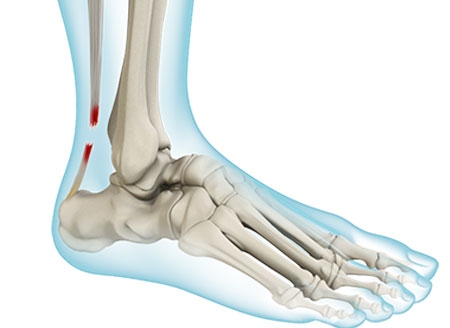As we continue our discussion of injuries seen during the winter months, Achilles tendon ruptures come to mind. A torn Achilles tendon can result from a fall that forces the foot into a dorsiflexed position (think toes forced towards your shin) or a forceful push-off motion that stresses the tendon beyond its capacity. The Achilles tendon attaches the calf muscle to the calcaneus (heel) bone in the foot, so when the calf is flexed, the ankle moves accordingly.Therefore, this injury often leaves patients struggling to walk normally as the function of the foot and ankle has been compromised. Without the tendon intact, the calf can no longer control the motion.
When patients come into our clinic, they often report that at the time of injury, it felt like they were kicked in the back of the leg, but when they turned around, no one was present. They often fall and struggle to put weight on their leg when they manage to get up. Typically they hobble around by putting a little weight onto the toes of the affected foot rather than being able to walk with a heel-to-toe motion. Swelling is often present in the foot and ankle after injury
When this injury is identified, our physicians order an x-ray of the side of the foot and ankle to assess any bone spurring (called a Haglund’s deformity) that may be present that could exacerbate problems with the Achilles tendon. Additionally, they can see if the tendon pulled off any small chunks of bone when it ruptured. Both of these instances can be rectified during surgical intervention. Evaluation of the Achilles tendon involves palpation of the surrounding region and squeezing the calf muscle to see if the foot plantar flexes as a result. If it does not,the Achilles tendon has been compromised. Most often, Achilles tendon tears require surgical intervention to regain function, though some peoples’ age and activity level are amenable to conservative management, especially if the ruptured ends of the tendon remain within close proximity to one another.
Surgical intervention involves reattaching the tendon to the calcaneus bone through an incision made along the back of the heel and Achilles. If a Haglund’s deformity was found on x-ray, it can be shaved down to prevent future problems. Once the tendon is reattached and the skin is closed, a short leg plaster splint is applied to immobilize the lower leg while the tendon starts to heal. At your post-operative clinic appointment, the splint will be removed and the stitches will be pulled from the incision. After a wound check, a short leg fiberglass cast (or some other form of immobilization) will be applied. Once you are about six weeks out from surgery, you will be transitioned to a walking boot with a heel lift so physical therapy can begin. Over time, you will regain strength, motion, and general function and wean out of your boot. We expect that you are getting back to your ‘normal’ three to six months after surgery.
Don’t let Achilles tendon injuries slow you down. Give us a call and get on the road to recovery today!
This blog is written by one of our very own-Morgan. She is a certified athletictrainer working as a medical assistant with our providers each and every day inour clinic. She obtained a bachelor's degree in athletic training from Carroll University in Waukesha and a master's degree in Kinesiology from MichiganState University. She is excited to bring you updates and information about thehappenings at OAW.

